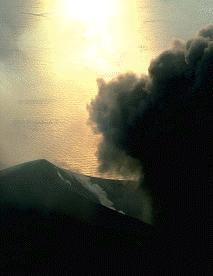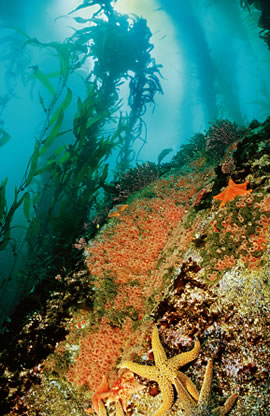Click on image for full size
Courtesy of NASA
Life in the Deep Ocean
The deep ocean is very cold, under high pressure, and always dark because sunlight can not penetrate that far. The only light comes from bioluminescence – a chemical reaction inside the bodies of some deep sea creatures. Less life can survive in the deep ocean than in other parts of the ocean because of these harsh conditions. For some animals, food comes from the bodies of dead fish, dead plankton, and even dead whales that rain down from the open ocean waters above.
But there are two extreme environments in the deep sea where life is more abundant: cold seeps and hydrothermal vents. In these environments, communities of living things do not rely on sunlight and photosynthesis to begin their food chains.
Cold seeps, areas where methane and hydrogen sulfide are released into the ocean, are home to many extremophiles – unusual creatures that can live without light. These creatures include clams, mussels, shrimp, crabs, bacteria, and tubeworms. For food, these animals depend on certain types of single-cell Archaea and Eubacteria that live off the methane and hydrogen sulfide from the seep. There are cold seeps in many different areas of the world’s ocean including one off the coast of Monterey, California (US). They tend to occur at the edges of continents.
Hydrothermal vents, another extreme environment in the deep sea, are located at tectonic spreading ridges. While most of the water in the deep ocean is close to freezing, the water at hydrothermal vents is very hot. Water seeps under the surface of the rock and is heated to 400 C (756 F) by volcanic activity at the spreading ridge. Then the hot water spews from holes in the crust called vents. The hot water looks like dark smoke as it gushes from the vents because it picks up dissolved chemicals underground. Most living things would die instantly in such a hot environment, but certain species of Archaea and Eubacteria thrive there. They are able to turn the chemicals from the hot water into the energy they need to survive. And that starts the food chains at hydrothermal vents. Many other types of living things including fish, shrimp, giant tubeworms, mussels, crabs, and clams thrive in this environment as well. They, too, are adapted to the hot water and high pressure. Some of them, like mussels, clams, and the giant, 2-meter (6-foot) tubeworms, get the nutrition they need from microbes living within their bodies. Others, like shrimp and barnacles, eat the Archaea and Eubacteria microbes.















